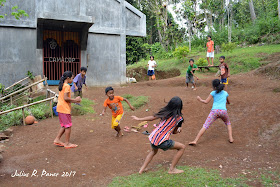Official duties prompted me to lead a double traverse climb in the
mountain ranges of Batuno, Sibulan and Tibolo together with other local
stakeholders to scout for possible bridge projects that may connect small
sitios in far-flung areas of Sta. Cruz. The presence of major rivers in these
areas necessitates putting up of bridges and even wider roads to cater to the
needs of the community in terms of agriculture and education. Local residents
also see potentials for tourism because there are unspoiled waterfalls,
beautiful sceneries and caves that could be future destinations.
The 2-day climb happened last May 8 and 9. Our first stop was Mt.
Batuno located in Barangay Jose Rizal. The long and moderate trail from Jose
Rizal proper to Batuno can be a good day hike and can even be an excellent
route for trail running given with the uphill single tracks. This mountain is
occupied by the Bagobos and although almost all portions of the area are titled
lot, biodiversity is still a thing to consider in establishing program
interventions especially infrastructure projects.
While taking our lunch in Batuno we chanced upon a century-old man
doing chores in his farmlands. His house was a vantage point where we saw the
panoramic sites of Davao City. Some agricultural farms made up of coconut,
banana and fruits trees are in abundance for which the old man also retained.
As we headed to Sibulan via sitios of Gurem I was refreshed by my
experience more than 10 years ago of the European-funded project called Upland
Development Programme (UDP) especially in the areas of Tabug, Gurem and
Dariango where we used to climb with my UDP colleagues. The vegetation in Tabug
remains lush and the river bordering Tabug to Dariango is still very attractive
even if some of its features were eliminated with the passing of time when the
hydropower plant progresses in the area.
We took a short break in the Christian church of Dariango and had some
native coffee break in the house of Tribal Leader Datu Gideon Tolentino. From
there we hiked up west to see the other target site for bridge project in the
circumference of sitio Tabug and sitio Landig and later went back to the Datu’s
house. It was already late afternoon when we left Dariango. A 30-minute descent
to Sibulan River was equally interesting, as we crossed Sibulan river in a
twilight zone, passing several familiar sceneries in Sibulan which includes
sitio Cagas Compound, Sibulan Proper and sitio Piping.
On the second day we took a 270-degree turn to Lower Tibolo via
Kapatagan road to do ocular inspection of an even extreme upstream portion of
Sibulan River, the Cabarisan-Lower Tibolo border. This is place I am used to
because we always take this as a venue of the Mt. Apo Boulder Face Challenge
specifically the trail where mountain bikers carry their mountain bikes from
the river to the open road of Tibolo and Kapatagan. Surprisingly, we were
greeted by a juvenile King Cobra on our way back.
Lower Tibolo is an approach to sitio Tudaya up northwest, sitios Landing
1 and 2 in the southeast and Barangay Kapatagan in extreme north and Davao City
in the northeastern part starting from sitio Cabarisan.

























